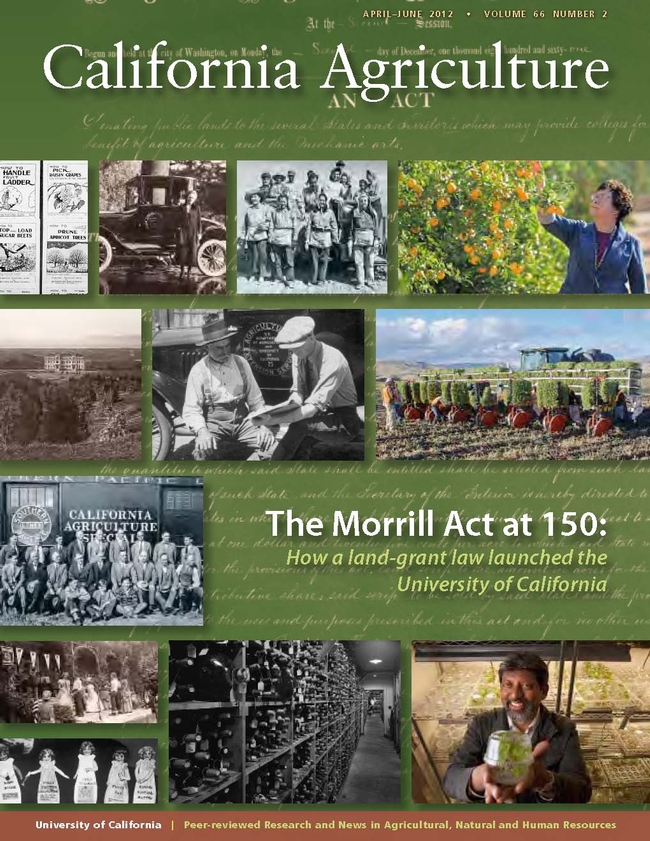
The Morrill Land-Grant College Act of 1862 gave federal public lands to states, allotting 30,000 acres for each senator and representative. States were encouraged to sell these “land grants” to raise money for new public universities that would educate Americans in agriculture, science and mechanical arts.
California legislators took the federal government up on its offer in 1864, and the first buildings of the University of California were completed in 1868 on the banks of Strawberry Creek, in the Berkeley hills.
In honor of the Morrill Act’s sesquicentennial, the April-June 2012 issue of California Agriculture journal includes extensive special coverage of how the 150-year-old land-grant law launched one of the world’s greatest systems of public higher education — the University of California.
“The nationwide university access the Morrill Act provided was certainly a game-changer in social mobility and economic prosperity,” UC President Mark G. Yudof wrote in California Agriculture. “Just as important was the Act’s intention to apply scientific research to farming methods and resources stewardship.”
California Agriculture’s special coverage of the Morrill Act anniversary includes an editorial by Yudof; an essay by Rose Hayden-Smith, UC Cooperative Extension advisor in Ventura County and historian; and a four-page photo gallery of rare and historic images. The entire April-June 2012 issue of California Agriculture can be viewed online at http://californiaagriculture.ucanr.edu.
In subsequent years, UC developed comprehensive statewide facilities that offered research, teaching and extension in agricultural, natural and human resources. The University Farm, established in Davis in 1906 as a teaching farm for UC Berkeley students, would later become UC Davis. The Citrus Experiment Station, founded in Riverside in 1907 to support California’s developing citrus industry, would become UC Riverside. And UC Cooperative Extension, established in 1914 as a federal, state and local partnership, works closely with the Agricultural Experiment Station to connect research with Californians in every county.
In her California Agriculture essay, Hayden-Smith describes the critical role that UC played in national wartime efforts.
“The importance of scientific agriculture and the role of land-grant institutions in promoting agricultural productivity were highlighted during World War I, when agricultural production and food security were viewed as vital to national security and victory ‘over there’,” wrote Hayden-Smith, a 4-H youth, family and community development advisor. UC provided instrumental support for undertakings such as victory gardens and school gardens, the Women’s Land Army, the Emergency Federal Labor Project, food conservation projects and new agricultural land settlements. In turn, these projects helped to build UC.
After World War II, the GI Bill of Rights spurred tremendous growth in college enrollment and further expansion of the University of California system, which now includes 10 campuses and generates some $46 billion in economic activity annually.
“The challenges we face together are far more complex than those California farmers faced in the 19th century,” Yudof wrote in California Agriculture. “Today we deal with issues like climate change, exotic invasive pests, food security, nutrition and childhood obesity, to name a few…True to the Morrill Act’s philosophy of melding science and agriculture, UC brings to the table the most visionary, industry-transformative research methods.”
Also in the April-June 2012 issue of California Agriculture:
Conservation tillage reduces water usage (research): UC researchers demonstrate that reducing or even eliminating tractor passes in Central Valley crop rotations — while maintaining crop residues on the soil surface — can significantly reduce the evaporation of irrigation water during typical growing seasons. Such methods, called conservation tillage, are gaining wider acceptance in California; a news story in the current California Agriculture notes that conservation tillage was used on more than 344,000 acres in the Central Valley in 2010. Additional research in 2011 showed that yields in cotton and tomato fields using conservation tillage were the same as in adjacent plots cultivated with conventional tillage.
Biotech strategies for fruit and nuts (research): A survey of major crop problems in California’s top 10 fruit and nut crops found that over the past 10 years little biotechnology research was directed toward these identified concerns. Likewise, the number of field permits issued for testing genetically engineered plants in California did not generally coincide with the major crop problems identified. The study found that citrus and grape are the focus of most current genetic engineering research and field permits in fruits, and walnut, rather than the more widely planted almond, is the focus among nut crops. The authors propose that transgrafting — the grafting of conventional scions onto genetically engineered rootstock — is a promising approach, but could result in regulatory questions for exported crops.
New quality index for kiwifruit (research): UC postharvest researchers propose that dry matter content, coupled with acidity measurements, are a better quality index for kiwifruit than soluble solids concentrations, which are currently used by most kiwifruit-producing countries. Consumer tests in 1999 and 2008 indicated that dry matter and ripe titratable acidity were related to in-store acceptance of kiwifruit. Likewise, a six-year survey of California kiwifruit harvested from vineyards in the Central Valley found that dry matter levels were highly variable among vineyards and seasons, but acidity levels varied more among seasons than between vineyards.
Sierra Nevada fire prevention (news): The Sierra Nevada Adaptive Management Project (SNAMP) — a unique collaboration between the U.S. Forest Service, UC and state and federal agencies — is developing methods to improve forest health and diminish fire danger in California via strategic fuel reduction treatments. As described in a California Agriculture news story, SNAMP research projects are focusing on forest health, public participation, water quality, ecosystem mapping, and the California spotted owl and Pacific fisher (http://snamp.cnr.berkeley.edu).
California Agriculture is the University of California’s peer-reviewed journal of research in agricultural, natural and human resources. For a free subscription, go to: http://californiaagriculture.ucanr.edu, or write to calag@ucdavis.edu.